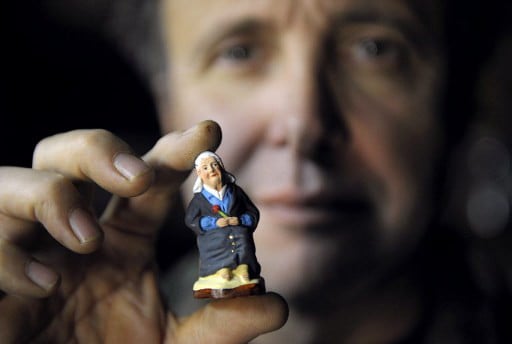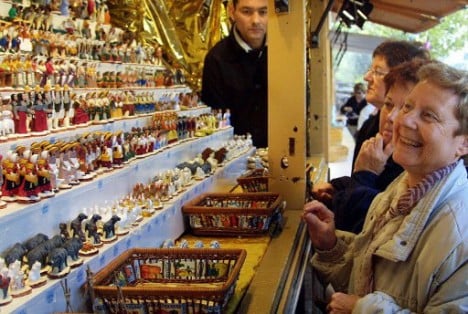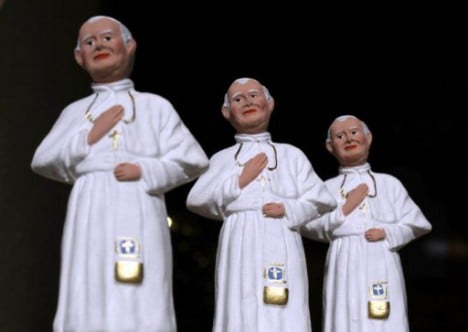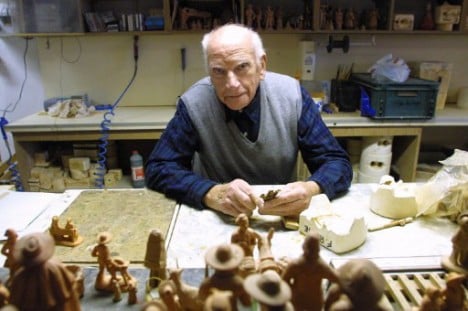The story behind France's Christmas tradition of little saints

Provence in the south of France adds a unique touch to its Christmas celebration with traditional 'santons', little figurines with a big history.
So what is a Santon? And how do you pronounce it?
A Santon (sounds like sonn-tonn) is a small, handmade clay figurine.
The characters typically represent vegetable sellers, bakers, men selling chestnuts, local dignitaries, or other personalities from daily village life.
And they're quite little indeed, usually between two and 15 centimetres in height.
 Where do I find them?
In nativity scenes all over France - but especially in the south. They originated in Provence.
Are these a new thing?
Hardly. They've been around in various forms for hundreds of years, but first took a clay form at the end of the 18th century thanks to the handiwork of Marseille-born artist Jean-Louis Lagnel.
He is generally credited with inventing the product as we know it today, although it wasn't until after his death in 1822 that they were called "Santons". Indeed, in Lagnel's time the figurines weren't heated up during the production process, so didn't last nearly as long as they do today.
Where do I find them?
In nativity scenes all over France - but especially in the south. They originated in Provence.
Are these a new thing?
Hardly. They've been around in various forms for hundreds of years, but first took a clay form at the end of the 18th century thanks to the handiwork of Marseille-born artist Jean-Louis Lagnel.
He is generally credited with inventing the product as we know it today, although it wasn't until after his death in 1822 that they were called "Santons". Indeed, in Lagnel's time the figurines weren't heated up during the production process, so didn't last nearly as long as they do today.
 Hang on, the end of the 18th century? This smells of the French revolution!
Indeed, well spotted. The French revolution saw nativity scenes banned and churches closed, so making the little saints was a way of secretly maintaining the religious traditions - at risk of being guillotined, of course.
Hang on, the end of the 18th century? This smells of the French revolution!
Indeed, well spotted. The French revolution saw nativity scenes banned and churches closed, so making the little saints was a way of secretly maintaining the religious traditions - at risk of being guillotined, of course.
 The word Santon literally translates as "Little Saint", but there is just as much a focus on the other characters in a village, as well as Mary, Joseph, and baby Jesus.
These nativity scenes are supposed to be representative of the ideal Provencal village.
How do you make a Santon?
With great patience, at least according to the ten-minute video below (which is well worth a watch).
If you haven't got a spare ten mins, here's the brief version:
An artist - called a santonnier - carves the figurine from clay, makes a two-piece plaster cast of it, then makes several more figurines from the plaster form.
The Santons are then dried, thrown in the kiln, and then hand painted, usually in very bright colours.
Santonniers often go to great lengths to make the backgrounds of the nativity scene too, including making buildings, using local produce for trees and plants, and putting clothes on the figurines.
The word Santon literally translates as "Little Saint", but there is just as much a focus on the other characters in a village, as well as Mary, Joseph, and baby Jesus.
These nativity scenes are supposed to be representative of the ideal Provencal village.
How do you make a Santon?
With great patience, at least according to the ten-minute video below (which is well worth a watch).
If you haven't got a spare ten mins, here's the brief version:
An artist - called a santonnier - carves the figurine from clay, makes a two-piece plaster cast of it, then makes several more figurines from the plaster form.
The Santons are then dried, thrown in the kiln, and then hand painted, usually in very bright colours.
Santonniers often go to great lengths to make the backgrounds of the nativity scene too, including making buildings, using local produce for trees and plants, and putting clothes on the figurines.
 And lastly... what if I want more?
Marseille usually holds a Santon festival, which has been going on since 1803. It's called the Foire aux Santons, and a scaled down version of it is running this year. If you'd rather avoid crowds though, why not take a walking tour of the fair via the YouTube video below?
Another version of this story was published in 2016.
And lastly... what if I want more?
Marseille usually holds a Santon festival, which has been going on since 1803. It's called the Foire aux Santons, and a scaled down version of it is running this year. If you'd rather avoid crowds though, why not take a walking tour of the fair via the YouTube video below?
Another version of this story was published in 2016.
Comments
See Also
So what is a Santon? And how do you pronounce it?
A Santon (sounds like sonn-tonn) is a small, handmade clay figurine.
The characters typically represent vegetable sellers, bakers, men selling chestnuts, local dignitaries, or other personalities from daily village life.
And they're quite little indeed, usually between two and 15 centimetres in height.

Where do I find them?
In nativity scenes all over France - but especially in the south. They originated in Provence.
Are these a new thing?
Hardly. They've been around in various forms for hundreds of years, but first took a clay form at the end of the 18th century thanks to the handiwork of Marseille-born artist Jean-Louis Lagnel.
He is generally credited with inventing the product as we know it today, although it wasn't until after his death in 1822 that they were called "Santons". Indeed, in Lagnel's time the figurines weren't heated up during the production process, so didn't last nearly as long as they do today.

Hang on, the end of the 18th century? This smells of the French revolution!
Indeed, well spotted. The French revolution saw nativity scenes banned and churches closed, so making the little saints was a way of secretly maintaining the religious traditions - at risk of being guillotined, of course.

The word Santon literally translates as "Little Saint", but there is just as much a focus on the other characters in a village, as well as Mary, Joseph, and baby Jesus.
These nativity scenes are supposed to be representative of the ideal Provencal village.
How do you make a Santon?
With great patience, at least according to the ten-minute video below (which is well worth a watch).
If you haven't got a spare ten mins, here's the brief version:
An artist - called a santonnier - carves the figurine from clay, makes a two-piece plaster cast of it, then makes several more figurines from the plaster form.
The Santons are then dried, thrown in the kiln, and then hand painted, usually in very bright colours.
Santonniers often go to great lengths to make the backgrounds of the nativity scene too, including making buildings, using local produce for trees and plants, and putting clothes on the figurines.

And lastly... what if I want more?
Marseille usually holds a Santon festival, which has been going on since 1803. It's called the Foire aux Santons, and a scaled down version of it is running this year. If you'd rather avoid crowds though, why not take a walking tour of the fair via the YouTube video below?
Another version of this story was published in 2016.
Join the conversation in our comments section below. Share your own views and experience and if you have a question or suggestion for our journalists then email us at [email protected].
Please keep comments civil, constructive and on topic – and make sure to read our terms of use before getting involved.
Please log in here to leave a comment.